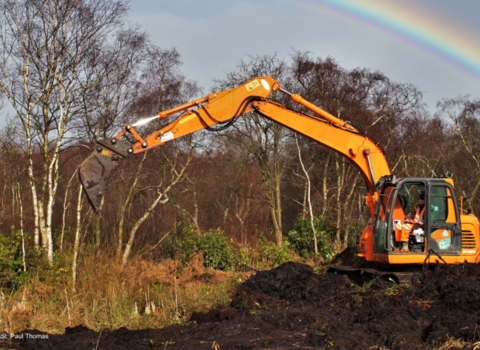What is peatland restoration?
Around 80% of UK peatlands have been modified or damaged because of past and present management, including drainage for purposes such as peat extraction, conversion to agricultural use and plantation forestry, as well as rotational managed burning1,2.
Peatland restoration aims to return damaged peatlands to a stable state where they can function naturally and support specialist peatland species. This is mainly achieved by restoring water levels, so they support the key wetland vegetation that is responsible for accumulating the organic layer and protecting the peat carbon store. Healthy peatlands are wetlands with high, stable water tables close to the surface.
Rewetting and restoring damaged peatlands is a proven approach that has been well developed in projects across the UK and internationally, and brings benefits for carbon, water and biodiversity3. The IUCN UK Peatland Programme’s UK Peatland Strategy sets a target of two million hectares of peatland in good condition, under restoration or being sustainably managed by 2040.
How do we restore peatlands?
Different techniques exist for different peatland habitat types and starting conditions, with the most important principle being to reverse the drainage and reduce or remove other negative impacts. This raises the water table and provides the right conditions for the growth of peat-forming plants such as Sphagnum mosses. In extreme cases where widespread erosion has led to deep gullies and bare peat, then revegetation may be required. Peatlands damaged by non-native conifer planting or encroachment by trees and shrubs due to drainage also require their removal.
Site evaluation
Before restoration activities begin, it is essential to establish a baseline dataset that describes the site. For example, the restoration of a commercial peat extraction site requires knowledge of the local hydrology, peat depth, underlying geology, topography, water chemistry and type of peat4.
Existing hydrology needs to be assessed, and drainage features mapped before they can be altered through restoration. An incomplete understanding of the hydrology of a site can lead to poor hydrological control and, thus, wasteful use of resources. Constructing a vegetation map of the site prior to restoration is also often necessary. On heavily degraded peatlands, peat and non-peat areas can be highlighted on a map. Tools such as Geographical Information Systems (GIS), aerial photographs and satellite imagery are available to support mapping vegetation, hydrology, and topography of a site.
As peatlands are important historical archives, restoration work must also avoid or minimise damage to historic environment features, which requires any work to be carefully planned. Historic England and Natural England have published guidance to support peatland restoration projects. Restoration goals and objectives (e.g., enhancing biodiversity, improving water quality, managing flood risk) must also be defined and agreed before restoration work begins.
Blocking drainage features
Vast areas of peatland have historically been drained through drainage channels (called ditches, gullies or grips) that were dug in the peat. Water and rainfall would run off the peatland through these channels, causing a drop in the water table depth and the die-back of peatland vegetation that thrives in wet conditions. To reverse these effects and to restore the hydrological function of a peatland, smaller grips and gullies (1-2 m wide) can be blocked with dams, trapping water and sediment, raising the water table, and preventing further erosion. The different types of dams used for rewetting can be impermeable (trapping water) or permeable (slowing the flow of water). Permeable dams allow sediment to build up in the gully, which can later be revegetated. Dams can be made from wood, stones, peat, heather bales, coir logs and plastic.
Stone dam. Credit Penny Anderson
Blocking of gullies can increase the surface storage of flood waters. Credit Penny Anderson
A coir log used to trap water in the North Pennines. Credit North Pennines National Landscape Partnership.
Restoring the hydrological function of fen peatlands is more complex. Fenlands are low-lying, often below sea level, and managed drainage systems have been introduced in these areas to drain the land for agricultural use. Such systems are expensive to maintain, but they contribute to flood management in lowland landscapes, protecting homes and businesses. Care must be taken when restoring the hydrological function of a degraded fen by altering the water levels, because doing so can affect the surrounding area that is not being restored. Furthermore, fenlands used for agricultural production often have high nutrient levels due to fertiliser application. Restoring agricultural fenlands requires these nutrient levels to be reduced. There is evidence that planting paludiculture crops, such as bulrush (Typha) could remove phosphorous and nitrogen from the water, and rewetting would cause further denitrification of the water5, but further trials are needed to evaluate this management option.
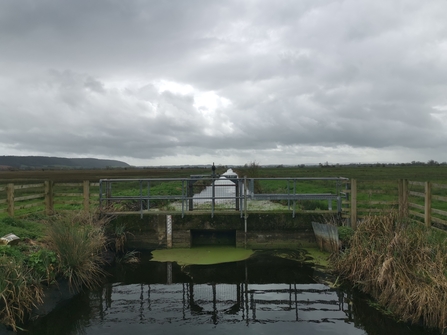
Internal drainage board channel in the Somerset Levels. Credit Jane Akerman.
Reprofiling
Gullies wider than 2 m are too large to dam so, where diggers can access, the eroding sides are reprofiled to a moderate angle of 33-45°. The newly angled slope is revegetated with the previously undermined vegetation. Where there is insufficient existing vegetation, heather brash can be spread on the slope to minimise further erosion. This reprofiling technique is also used on peat hags (isolated mounds of vegetated peat) not associated with gullies.
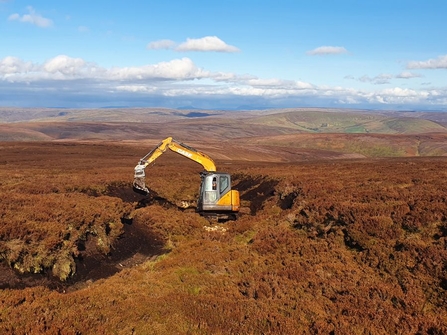
Machine operator reprofiling a gully. Credit Pennine PeatLIFE
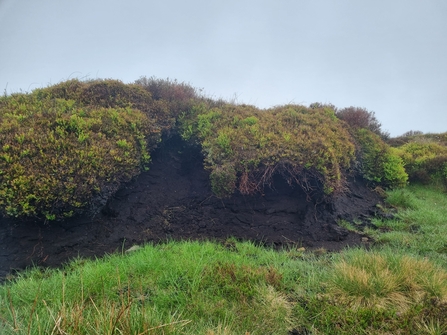
A peat hag on Kinder Scout, Peak District National Park. Credit Emma Hinchliffe.
Revegetation of bare peat
Exposed bare peat is caused by several factors including air pollution, livestock movement and overgrazing, vehicle damage, peat extraction for fuel use and fire. The absence of surface vegetation exposes peat to erosion and the washing of peat into watercourses.
One of the commonest techniques to revegetate bare peat is to spread cut heather brash that contains heather seeds and fragments of mosses that grow naturally on wet heath or drier peat bogs. The brash stabilises the peat surface, prevents further erosion and creates microclimates for bog vegetation to establish. Once the peat has been stabilised, seeds of grasses and dwarf shrubs are sown, often by using a helicopter to cover large areas.
In areas affected by historic air pollution, such as the Peak District, peat can be as acidic as lemon juice6, and lime must be applied to make the peat more alkaline to encourage grasses to establish. Fertiliser may also be required to encourage growth. The grasses initially provide stability and protection to other seedlings but will be replaced by typical peatland vegetation over time.
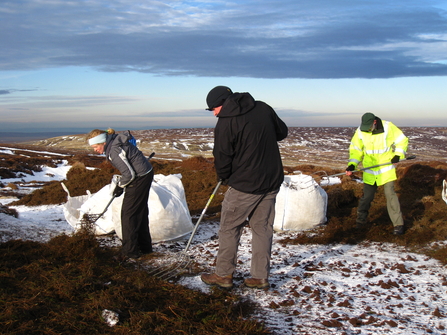
Brash spreading on Killhope, County Durham. Credit Elizabeth Pickett.
The most important species in blanket bog and raised bog restoration – both biologically and structurally – are Sphagnum mosses. If Sphagnum is absent from a degraded site, it can be propagated offsite, and Sphagnum plug plants can then be introduced to the area that is being restored. For example, BeadaMoss® produces micropropagated Sphagnum for peatland restoration projects in the UK. Their work with Moors for the Future Partnership was showcased in the film ‘The most important plant in the world’, specially commissioned by the IUCN UK Peatland Programme and created by artist Caroline Vitzthum.
Sphagnum Portraits: The most important plant in the world (https://youtu.be/hNUWjq1FW6k)
Sphagnum Portraits: The most important plant in the world.
Once the Sphagnum has established, a typical peatland plant community starts to build up and water is retained on the peatland. The restoration of vegetation also allows for reintroduction of different species to their former range. For example, the white-faced darter, large heath butterfly and large marsh grasshopper have all been re-introduced to restored sites in the UK.
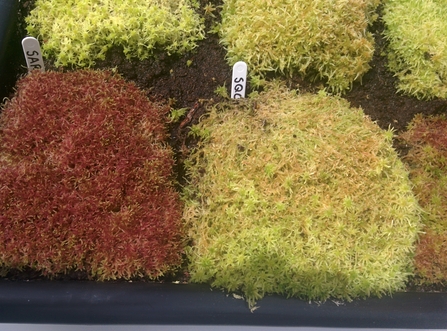
Sphagnum micropropagation. Credit Emma Hinchliffe.
Forest to bog restoration
‘Forest to bog’ restoration refers to the removal of plantation (predominantly conifer) forestry from areas that were once open peatland habitat, and the subsequent restoration of peatland structure and function. Compared to other restoration activities, forest to bog restoration can be a much more involved, complex, and costly undertaking due to the comprehensive degradation of the peatland habitat and added complexities of removing forestry and changing the use of the land. Forest to bog restoration generally consists of four steps: felling of existing trees, brash removal, surface reprofiling and rewetting. During the early post-restoration stages, there is a risk of conifer regeneration from dormant seeds, which may require further management. However, recovering water tables eventually deter the growth of such seedlings.
Find out more about forest to bog restoration in our publication ‘Forest to Bog Restoration: Demonstrating Success’.
Monitoring
Monitoring of restoration work can indicate whether the objectives of restoration work (e.g., improving water quality, protecting carbon stores) are being met. Monitoring can involve assessing changes in peat depth, hydrology, biota (plants, birds, invertebrates) or peat and water chemistry7. If restoration is failing to meet the set objectives, different restoration techniques may be applied, or restoration objectives may be revised. Once the restoration work has been completed, it is essential to continue monitoring the site over the long term to assess the effectiveness of the restoration work undertaken. Guidelines have been developed to select suitable monitoring techniques in the UK - see: Natural England: Guidelines for monitoring peatland restoration and Peatland ACTION - Monitoring strategy | NatureScot.
However, there is often a lack of funding for long-term monitoring of restoration projects. The IUCN UK Peatland Programme’s ‘Eyes on the Bog’ provides a suite of simple, affordable methods to capture information about the state of peatlands over the long term and can be employed by local volunteers acting as citizen scientists. Find out more on our dedicated webpage.
How much does peatland restoration cost?
Peatland restoration can be a costly undertaking. In the UK, the median cost of peatland restoration in 2019 was estimated to be £1,009 per hectare, with a difference of £3,707 between minimum and maximum costs8, although this can vary significantly. In Scotland, the median cost of peatland restoration in 2022 was £1,026 per hectare9.
Restoration costs are made up of the cost of restoration works in the field, staff costs (engaging experts such as peat restoration officers), opportunity costs (negative impacts on commercial values that may arise from changing land use) and other costs (e.g., employing external consultants or contactors). The costs of different restoration techniques also vary – a study found that gully blocking with rocks was the most expensive technique (£5,883 per hectare), in contrast to gully blocking with peat (£105 per hectare)8, but it’s important that the right technique is used in the right place. Some techniques are more costly as they require expensive equipment (such as tree harvesting or reprofiling) and costs can be higher on remote or high-altitude sites that require machinery to be transported for long distances. Find out more about the cost of various techniques here.
Peatland restoration projects can be funded through public and private finance, or a combination of both. Public funding is estimated to be the main source of funding in England8, Wales and Northern Ireland, with government support schemes such as England’s Nature for Climate Peatland Grant Scheme or Wales’ Peatland Restoration Grant providing support for restoration. However, the dominance of public funding means that restoration is affected by the policy and funding environment. Peatland restoration is a long-term process, and it can be difficult to secure long-term funding and plan accordingly - this is also a challenge when engaging contractors.
To facilitate investment in peatland restoration, The Peatland Code was set up by the IUCN UK Peatland Programme as a voluntary green finance standard. This initiative supports private and blended funding of peatland restoration through the sale of carbon credits based on reductions in carbon emissions when degraded peatlands are restored. The Peatland Code is undergoing continuous development to include additional forms of peatland restoration, as well as credits for additional ecosystem services such as biodiversity. In Scotland, Peatland ACTION supports many projects funded through a combination of public and private finance.
The use of helicopters to transport restoration materials to remote sites is often necessary but makes restoration more expensive. Credit North Pennines National Landscape Partnership.
Who is restoring our peatlands?
Peatland restoration in the UK is undertaken by various peatland partnerships that consist of multiple organisations including NGOs, local and regional government agencies, water companies, landowners, farmers, businesses and others. In Scotland, the main delivery body is Peatland ACTION, whilst in Wales, restoration work is coordinated by Natural Resources Wales through the National Peatland Action Programme. Different partnerships exist across England and Northern Ireland, many of which are summarised on the map below.
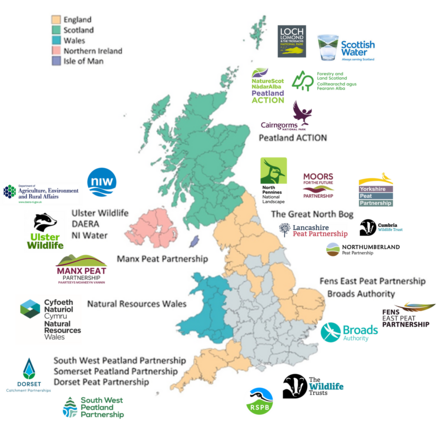
Organisations involved in peatland restoration across the UK.
Peatland restoration is a long-term process
Peatlands in the UK developed over thousands of years and restoring a damaged peatland is a long-term process that takes many decades. However, funding bodies often expect rapid results after the first few years of restoration. These attitudes are highlighted when comparing peatland management to forest management: when planting a forest, it is recognised that trees require decades to form a fully established forest. Whilst peatlands are often much longer lived than forests, expectations may be very different, which can influence policy and funding streams.
Whilst some peatland responses can be rapid and visible after such short time scales, restored peatlands generally require time to stabilise and reestablish natural ecosystem functions. This fundamental rule of peatland restoration management should be recognised by everyone involved, from policy makers to practitioners10.
Peatland restoration can be a costly, lengthy process; however, unless urgent action is taken to prevent further deterioration of our damaged peatlands the costs to society could reach billions of pounds, far outweighing the cost of repair now.
Resources
Explore interactive maps to find out where peatland is being restored in Scotland and Wales: Peatland ACTION - Data mapping portal | NatureScot and Welsh Peatland Data Portal | Wales Environmental Information Portal (arcgis.com).
Read about successful peatland restoration projects in the UK and internationally.
Read a review of peatland restoration from the IUCN UK Peatland Programme’s 2011 Commission of Enquiry on Peatlands: Peatland Restoration.
Grip and gully blocking on upland peatlands: Grip-and-gully-blocking-Factsheet.pdf (moorsforthefuture.org.uk)
The cost of peatland restoration: (PDF) How much does peatland restoration cost? Insights from the UK
References
-
Bain CG, Bonn A, Stoneman R, Chapman S, Coupar A, Evans M et al. IUCN UK Commission of Inquiry on Peatlands. IUCN UK Peatland Programme. 2011. IUCN UK Commission of Inquiry on Peatlands Full Report spv web.pdf.
- Evans C, Artz R, Moxley J, Smyth MA, Taylor E, Archer E et al. Implementation of an emissions inventory for UK peatlands. Centre for Ecology and Hydrology. 2017; 1-88. Available from: Report: Implementation of an Emissions Inventory for UK Peatlands - DEFRA UK Air - GOV.UK.
-
IUCN Peatland Programme. Peatland Restoration: An introduction. An Introduction to Restoration Techniques
-
Thom T, Hanlon A, Lindsay R, Richards J, Stoneman R, Brooks S. Conserving Bogs: the Management Handbook. 2019; 1-207. Conserving Bogs The Management Handbook 2nd Edition
-
Comber S, Lunt P, Taylor M, Underwood N, Crocker R, Schindler R. Restoration management of phosphorus pollution on lowland fen peatlands: A data evidence review from the Somerset Levels and Moors. Agricultural Water Management. 2023; 278: 108419. https://doi.org/10.1016/j.agwat.2023.108419
-
Moors for the Future Partnership. Stabilising and revegetating bare peat. Stabilising and revegetating bare peat | Moors for the Future
-
Natural England. Guidelines for monitoring peatland restoration. 2011; 1-31. Available from: Guidelines for monitoring peatland restoration - TIN097.
-
Okumah M, Walker C, Martin-Ortega J, Ferré M, Glenk K, Novo P. How much does peatland restoration cost? Insights from the UK. University of Leeds - SRUC Report. 2019. Available from: (PDF) How much does peatland restoration cost? Insights from the UK.
- SEFARI. The cost of peatland restoration in Scotland. The cost of peatland restoration in Scotland | SEFARI.
- Lindsay R, Birnie R, Clough J. Peatland restoration. IUCN UK Peatland Programme Briefing Note No 11. 2016. Briefing 11 Peatland restoration.pdf.

